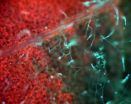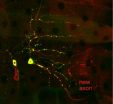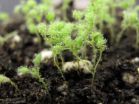(Press-News.org) SAN ANTONIO — While endogenous estrogen (i.e., estrogen produced by ovaries and by other tissues) does have a well-known carcinogenic impact, hormone replacement therapy (HRT) utilizing estrogen alone (the exogenous estrogen) provides a protective effect in reducing breast cancer risk, according to study results presented at the 33rd Annual CTRC-AACR San Antonio Breast Cancer Symposium, held Dec. 8-12.
"Our analysis suggests that, contrary to previous thinking, there is substantial value in bringing HRT with estrogen alone to the guidelines. The data show that for selected women it is not only safe, but potentially beneficial for breast cancer, as well as for many other aspects of women's health," said lead researcher Joseph Ragaz, M.D., medical oncologist and clinical professor in the faculty of medicine, School of Population and Public Health at The University of British Columbia, Vancouver, BC, Canada.
"These findings should intensify new research into its role as a protective agent against breast cancer," he added.
Ragaz and colleagues reviewed and reanalyzed data from the Women's Health Initiative (WHI) hormone replacement therapy trials. WHI is a national health study that focuses on strategies for preventing heart disease, breast and colorectal cancer, and fracture in postmenopausal women. The WHI was launched in 1991 and includes more than 161,000 U.S. women aged 50 to 79 years.
"Over the last 30 years HRT has been used almost indiscriminately by women expecting the benefit of reducing cardiac risks, while providing a protective effect against bone fracture, and improving overall quality of life," said Ragaz. "The WHI results as originally interpreted led to a major pendulum swing against HRT."
The WHI HRT trial consisted of two cohorts of women; the estrogen-alone group of women without a uterus and the estrogen-plus-progestin group of women with a uterus.
Ragaz and colleagues reanalyzed the WHI studies in more detail and found that subsets of women with no strong family history of breast cancer who received estrogen alone had a significantly reduced breast cancer incidence. In addition, the 75 percent of women without benign disease prior to the trial enrollment also had a reduced breast cancer risk.
"Reduction of rates of breast cancer in the majority of women who are candidates for estrogen-based HRT is a new finding because estrogen was always linked with a higher incidence of breast cancer," Ragaz said, "yet estrogen administered exogenously is actually protective for most women."
Based on the results of this current analysis, Ragaz suggested that "while the use of HRT with estrogen alone may reduce the risk of breast cancer and may also be appropriate to manage menopausal symptoms, further research is warranted to elaborate on the optimum treatment regimen, to refine the selection of ideal candidates for estrogen therapy, and to understand the estrogen mechanisms that support the prevention of human breast cancer."
"The recommendations based on prior analyses of the results of the WHI HRT studies was not to use HRT, but we are optimistic this will change," he said. "Our conclusion, based on the data presented, should enhance considerations for an early approval of HRT based on estrogen-alone for the majority of selected women suffering with menopausal symptoms and galvanize new research on HRT to define the optimum regimens for individual women."
###
Follow the AACR on Twitter @AACR, and throughout the meeting using the hash tag #SABCS.
Recordings of the teleconferences and video interviews with researchers will posted to the AACR website throughout the meeting: http://www.aacr.org/page23506.aspx.
The mission of the CTRC-AACR San Antonio Breast Cancer Symposium is to produce a unique and comprehensive scientific meeting that encompasses the full spectrum of breast cancer research, facilitating the rapid translation of new knowledge into better care for breast cancer patients. The Cancer Therapy & Research Center (CTRC) at The University of Texas Health Science Center at San Antonio, the American Association for Cancer Research (AACR) and Baylor College of Medicine are joint sponsors of the San Antonio Breast Cancer Symposium. This collaboration utilizes the clinical strengths of the CTRC and Baylor, and the AACR's scientific prestige in basic, translational and clinical cancer research to expedite the delivery of the latest scientific advances to the clinic. The 33rd annual symposium is expected to draw nearly 9,000 participants from more than 90 countries.
Estrogen alone is effective for reducing breast cancer risk
2010-12-10
ELSE PRESS RELEASES FROM THIS DATE:
Results of AZURE to be presented at the CTRC-AACR San Antonio Breast Cancer Symposium
2010-12-10
SAN ANTONIO — The long-awaited results of the Adjuvant Treatment with Zoledronic Acid in Stage II/III Breast Cancer, the AZURE trial, will be presented at the 33rd Annual CTRC-AACR San Antonio Breast Cancer Symposium, held here Dec. 8-12.
"Adjuvant use of bisphosphonates like zoledronic acid is widespread among women with breast cancer, and the results of this trial will help answer many questions as well invite new ones," said Robert Coleman, M.D., professor of medical oncology at the University of Sheffield in England.
Coleman will present the results of AZURE during ...
Exemestane may be another first-line, adjuvant therapy for hormone-receptor positive, early-stage breast cancer
2010-12-10
SAN ANTONIO — Exemestane, an aromatase inhibitor that blocks production of estrogen, may provide another post-surgery option for postmenopausal women with hormone-receptor positive, early-stage breast cancer.
In the first head-to-head adjuvant clinical trial comparing two aromatase inhibitors, anastrozole and exemestane, the drugs resulted in similar survival rates and prevention of breast cancer recurrences. Some differences in the side effect profile were seen, including a potential difference in the risk of developing osteoporosis.
Paul E. Goss, M.D., Ph.D., professor ...
Genome of barley disease reveals surprises
2010-12-10
Scientists have sequenced the genome of a major fungal disease that affects barley and other cereal crops, a breakthrough that could lead to significant advances in our understanding of how plant diseases evolve. The research, published today in the journal Science, suggests that parasites within the genome of the fungus help the disease to adapt and overcome the plant's defences.
The study could help with the development of new agricultural techniques for protecting cereal crops from infection. Barley grains are the basis of many staple foods, and also central to the ...
The end of planet formation, as told by trace elements from the mantles of Earth, the moon and Mars
2010-12-10
New research reveals that the abundance of so-called highly siderophile, or metal-loving, elements like gold and platinum found in the mantles of Earth, the Moon and Mars were delivered by massive impactors during the final phase of planet formation over 4.5 billion years ago. The predicted sizes of the projectiles, which hit within tens of millions of years of the giant impact that produced our Moon, are consistent with current planet formation models as well as physical evidence such as the size distributions of asteroids and ancient Martian impact scars. They predict ...
Gene hunters tackle crop diseases
2010-12-10
Norwich scientists are on the trail of some of the most economically damaging organisms that infect crops worldwide. Their latest targets are the parasitic water fungus that causes powdery mildew and the water molds that cause late blight in potatoes and tomatoes and downy mildew in cruciferous vegetables and other crops.
"We have been studying the late blight pathogen for a while," said Professor Sophien Kamoun, head of the Sainsbury Laboratory on the Norwich Research Park. "In separate research we are trialling plant genes that mediate blight resistance, while in this ...
Key protein discovered that allows nerve cells to repair themselves
2010-12-10
A team of scientists led by Melissa Rolls, an assistant professor of biochemistry and molecular biology at Penn State University, has peered inside neurons to discover an unexpected process that is required for regeneration after severe neuron injury. The process was discovered during Rolls's studies aimed at deciphering the inner workings of dendrites -- the part of the neuron that receives information from other cells and from the outside world. The research will be published in the print edition of the scientific journal Current Biology on 21 December 2010.
"We already ...
Thought for food: New CMU research shows imagining food consumption reduces actual consumption
2010-12-10
PITTSBURGH—If you're looking to lose weight, it's okay to think about eating your favorite candy bar. In fact, go ahead and imagine devouring every last bite — all in the name of your diet.
A new study by researchers at Carnegie Mellon University, published in Science, shows that when you imagine eating a certain food, it reduces your actual consumption of that food. This landmark discovery changes the decades-old assumption that thinking about something desirable increases cravings for it and its consumption.
Drawing on research that shows that perception and mental ...
Massive gene loss linked to pathogen's stealthy plant-dependent lifestyle
2010-12-10
An international team of scientists, which includes researchers from Virginia Tech, has cracked the genetic code of a plant pathogen that causes downy mildew disease. Downy mildews are a widespread class of destructive diseases that cause major losses to crops as diverse as maize, grapes, and lettuce. The paper describing the genome sequence of the downy mildew pathogen Hyaloperonospora arabidopsidis, which attacks the widely studied model plant Arabidopsis thaliana, is the cover story of this week's edition of the journal Science.
In the paper, the sequence of H. arabidopsidis ...
Cutting dietary phosphate doesn't save dialysis patients' lives
2010-12-10
Doctors often ask kidney disease patients on dialysis to limit the amount of phosphate they consume in their diets, but this does not help prolong their lives, according to a study appearing in an upcoming issue of the Clinical Journal of the American Society Nephrology (CJASN). The results even suggest that prescribing low phosphate diets may increase dialysis patients' risk of premature death.
Blood phosphate levels are often high in patients with kidney disease, and dialysis treatments cannot effectively remove all of the dietary phosphate that a person normally consumes. ...
Duchenne muscular dystrophy is ultimately a stem cell disease
2010-12-10
Researchers have long known that the devastating disease called Duchenne muscular dystrophy (DMD) is caused by a single mutation in a gene called dystrophin. The protein encoded by that gene is critical for the integrity of muscle; without it, they are easily damaged. But new findings in mice reported online in the journal Cell on December 9th by researchers at Stanford suggest that disease symptoms, including progressive muscle weakening leading to respiratory failure, only set in when skeletal muscle stem cells can no longer keep up with the needed repairs.
"This is ...


